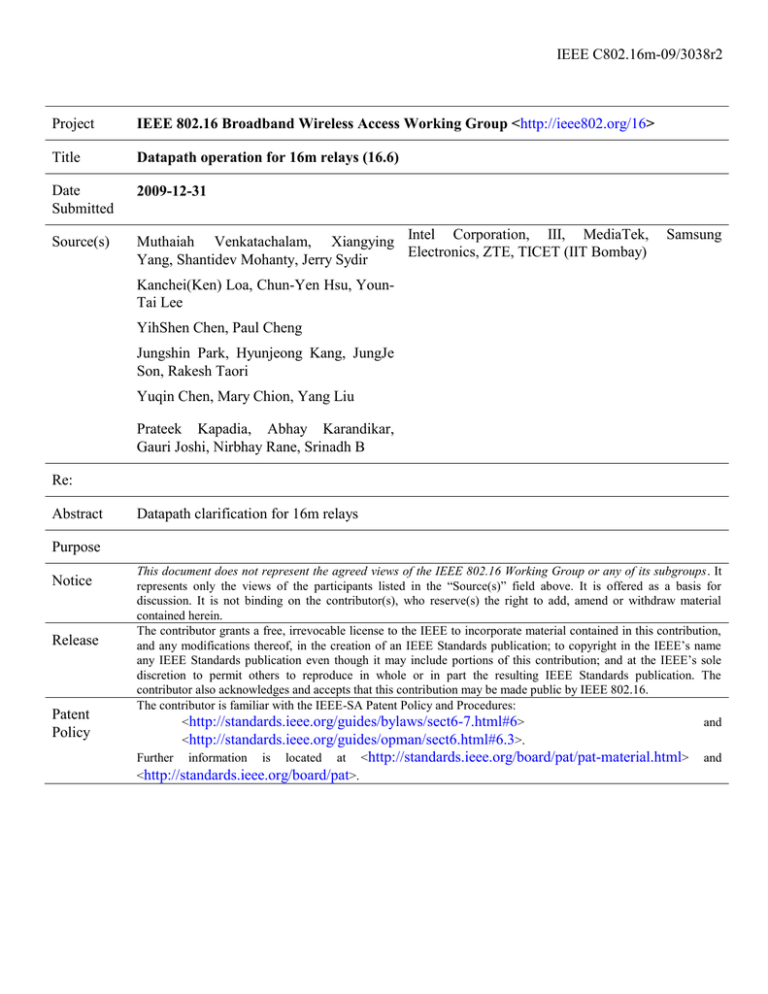IEEE C802.16m-09/3038r2 Project Title
advertisement

IEEE C802.16m-09/3038r2
Project
IEEE 802.16 Broadband Wireless Access Working Group <http://ieee802.org/16>
Title
Datapath operation for 16m relays (16.6)
Date
Submitted
2009-12-31
Source(s)
Muthaiah Venkatachalam, Xiangying Intel Corporation, III, MediaTek,
Electronics, ZTE, TICET (IIT Bombay)
Yang, Shantidev Mohanty, Jerry Sydir
Samsung
Kanchei(Ken) Loa, Chun-Yen Hsu, YounTai Lee
YihShen Chen, Paul Cheng
Jungshin Park, Hyunjeong Kang, JungJe
Son, Rakesh Taori
Yuqin Chen, Mary Chion, Yang Liu
Prateek Kapadia, Abhay Karandikar,
Gauri Joshi, Nirbhay Rane, Srinadh B
Re:
Abstract
Datapath clarification for 16m relays
Purpose
Notice
Release
Patent
Policy
This document does not represent the agreed views of the IEEE 802.16 Working Group or any of its subgroups. It
represents only the views of the participants listed in the “Source(s)” field above. It is offered as a basis for
discussion. It is not binding on the contributor(s), who reserve(s) the right to add, amend or withdraw material
contained herein.
The contributor grants a free, irrevocable license to the IEEE to incorporate material contained in this contribution,
and any modifications thereof, in the creation of an IEEE Standards publication; to copyright in the IEEE’s name
any IEEE Standards publication even though it may include portions of this contribution; and at the IEEE’s sole
discretion to permit others to reproduce in whole or in part the resulting IEEE Standards publication. The
contributor also acknowledges and accepts that this contribution may be made public by IEEE 802.16.
The contributor is familiar with the IEEE-SA Patent Policy and Procedures:
<http://standards.ieee.org/guides/bylaws/sect6-7.html#6>
and
<http://standards.ieee.org/guides/opman/sect6.html#6.3>.
Further information is located at <http://standards.ieee.org/board/pat/pat-material.html> and
<http://standards.ieee.org/board/pat>.
IEEE C802.16m-09/3038r2
Datapath clarification for 16m relays
Introduction
In Advance WirelessMAN-OFDMA deployment supporting relay, a distributed control model is used. The user
plane protocol architecture is illustrated in Figure XXX. Upon the ABS receiving the user plane packets from the
ASN, the received packets are mapped to a transport flow of AMS. The mapping mechanism is out of scope of this
specification. The user plane packets are first packed into a MPDU with corresponding FID in GMH, and then
MPDUs are encapsulated in the relay MPDU of ARS and mapped to a transport flow with similar QoS over the relay
link.
Figure XXX ARS user plane protocol stack
The control plane protocol architecture is shown in Figure YYY. In this case, the ASN control messages are sent
between ASN and ABS, and between ABS and ARS. Upon ABS receiving the ASN control message, it read the
AMS ID in the message and translate the ASN control message between the two interfaces by means of encapsulate
the ASN control message in a AAI_L2_XFER message (leaving the ASN control message unchanged) and send to
the target ARS with FID=FFS. This operation corresponds to an ASN control proxy mechanism. The ASN control
proxy operation would be transparent for ASN and ARS. That is, as seen from ASN it looks like as if ARS would be
connected via ABS, while from the ARS’s perspective it would look like as if ARS would be talking to ASN
directly. Over the relay link, ARS’s ASN control messages are carried in AAI_L2_XFER messages.
Fig. YYY ARS control plane protocol stack
IEEE C802.16m-09/3038r2
[Note to Editor: Modify the text in section 16.6 as follows]
16.6 Support for Relay
16.6.1 Relay Modes and General Description
In Advance WirelessMAN-OFDMA System, support for relay is an optional feature. The AMSs may associate
either with an ARS or an ABS and receive services from the ARS or ABS that they are attached to.
Relaying in Advance WirelessMAN-OFDMA System is performed using a decode and forward paradigm. Both,
TDD and FDD modes for Duplexing the DL and UL are supported. In TDD deployments ARSs operate in TTR
mode, whereby the access and relay link communications are multiplexed using time division multiplexing
within a single RF carrier.
In Advance WirelessMAN-OFDMA System, the ARSs operate in non-transparent mode which essentially
means that
(a) the ARSs compose the SFH and the A-MAPs for the subordinate stations
(b) the ARSs transmit the A-Preamble , SFH and A-MAPs for the subordinate stations.
In Advance WirelessMAN-OFDMA deployment supporting relay, a distributed scheduling model is used where
in each infrastructure station (ABS or ARS) schedules the radio resources on its subordinate link. In case of an
ARS, the scheduling of the resources is within the radio resources assigned by the ABS. The ABS notifies the
ARSs and AMSs of the frame structure configuration. The radio frame is divided into access and relay zones as
described in section 16.6.3.1.
In the access zone, the ABS and the ARS transmit to, or receive from, the AMSs. In the relay zone, the ABS
transmits to the ARSs and the AMSs, or receives from the ARSs and AMSs. The start times of the frame
structures of the ABS and ARSs are aligned in time. The ABS and ARSs transmit A-Preamble, SFH, and AMAPs to the AMSs at the same time.
The ABS may exercise control over the manner in which ARSs utilize the resources within the access zone.
16.6.2 MAC access control
16.6.2.1 Addressing
16.6.2.1.1 Station Identifier (STID)
The ABS assigns an STID to the ARS during network entry. The STID uniquely identifies the ARS within the
domain of the ABS. The structure of the STID is described in section 16.2.1.2.1.
The ARS manages and assigns the STID for the AMS during the AMS initial network entry into the ARS.
16.6.2.1.2 Flow Identifier (FID)
The ARS assigns and manages the FID for the AMS during the AMS DSA procedure with the ARS.
IEEE C802.16m-09/3038r2
The ABS manages and assigns the FID for the ARS on the relay link.
An FID, unique within the ARS, is assigned to each connection on the ABS-ARS link. The structure of the FID
is described in section 16.2.1.2.2.
The prime function of an ARS is to relay MAC PDUs between the ABS and the AMS, for which one or more
connections may be established between the ABS and the ARS. Only the control connections, meant for
transporting control messages between the ABS and the ARS, terminate at the ARS.
16.6.2.2 MPDU Formats
MAC PDUs ASN data traffic for AMSs sent on the relay connections on the relay link shall be encapsulated
into a relay MAC PDU. The format of the relay MAC PDU is illustrated in Figure xxx.
GMH
EH
Payload
MAC PDU
AMS1
GMH
MAC PDU
AMS2
EH
MAC PDU
AMSn
Payload
ASN Data trf
1
ASN Data trf
1
ASN Data trf
n
Figure 576 Relay MAC PDU format
Each relay MAC PDU shall begin with a Generic MAC header. The format of GMH is same as defined in
section 15.2.2.1.1. The GMH may be followed by one or more extended headers. The relay MAC PDU shall
also contain a payload. The payload consists of one or more AMSs’ MAC PDUs ASN data traffic.
MAC PDUs for the ARS sent on the control connections on the relay link shall follow the same format as
shown in Figure 385.
[Delete the whole subsection “16.6.2.2.1 STID Extended header”]
[Change the subsection number of 16.6.2.2.2 to 16.6.2.2.1]
16.6.2.2.1 STID Extended header
IEEE C802.16m-09/3038r2
Table yyy - STID Extended Header Format
Syntax
Size (bit)
Notes
STID Extended header() {
Last
1
Last Extended Header indication:
0 = one or more extended header
follows the current extended header
unless specified otherwise;
1 = this extended header is the last
extended header unless specified
otherwise
Type
TBD
STID EH
STID
12
Identity of the AMS, which tansmits
or receives MAC PDU.
End
1
1: This STID is the last STID;
Do{
0: one or more STID follows.
}While(!End)
}
16.6.2.2.21 Length Extended header
The length extended header (LEH) is added to relay MAC PDU when the relay MAC PDU length is greater that
2048 bytes. The LEH if present in the relay MAC PDU, shall be the first extended header in the relay MAC
PDU. The format of LEH is defined in Table zzz. The Length field in LEH gives the 3 MSBs of 14 bit extended
length of relay MAC PDU. The length field in GMH gives the 11 LSBs of 14 bit extended length of relay MAC
PDU.
Table zzz – Length Extended header Format
Syntax
Size (bit)
Notes
Length Extended header() {
Last
1
Last Extended Header indication:
0 = one or more extended header
follows the current extended header
unless specified otherwise;
1 = this extended header is the last
extended header unless specified
otherwise
IEEE C802.16m-09/3038r2
Type
Length
TBD
Length EH
3
3 MSB length fields to indicate the
length of relay MAC PDU. The 11
LSBs of Length field exist in the
GMH.
}
16.6.2.3 Construction and Transmission of MPDUs
16.6.2.3.1 Concatenation
In Multi-Hop Relay networks, multiple MAC PDUs for an ARS and multiple relay MAC PDUs can be
concatenated into a single transmission on the relay link.
16.6.2.3.21 Data Forwarding Scheme
For DL transmission via an ARS, when an ABS transmits data to AMSs via the ARS, the ABS shall encapsulate
MAC PDUs ASN data traffic of one or multiple target AMSs into a relay MAC PDU of the ARS and
appends an STID Extended header. The ARS shall decode the DL basic assignment A-MAP IE to receive relay
MAC PDUs. The ARS shall de-encapsulate received relay MAC PDU and transmits the MAC PDUs ASN data
traffic to target AMSs in format of MAC PDU. based on STID in STID Extended header.
For UL transmission via an ARS, the ARS shall encapsulate the ASN data traffic MAC PDUs from one or
multiple AMSs into a relay MAC PDU and appends an STID Extended header. The ABS decodes the received
relay MAC PDU and extracts MAC PDUs for each AMS.
16.6.2.4 Security
ARS uses the same security architecture and procedures as an AMS to provide privacy, authentication and
confidentiality between itself and ABS on the relay link.
An ARS is operating as distributed security mode. The AK established between AMS and authenticator is
distributed to this ARS during key agreement.
As shown in Fig N, after authorization for AMS completes and the MSK for AMS is established, the ARS starts
key agreement with the AMS. During the key agreement, the authenticator shall transfer the relevant
Authorization Key (AK) context associated with the AMS to its ARS. On obtaining AK context the ARS
derives necessary security keys such as CMAC keys and TEK from the AK and ARS is responsible for key
management of AK, CMAC keys and TEK, and interacts with the AMS as if it were an ABS in the AMS’s
perspectives.
During the key agreement, similarly to macro BS, the Security Association shall be established between an
IEEE C802.16m-09/3038r2
AMS and an ARS. ARS uses the set of active keys shared with the AMS to perform encryption/decryption and
integrity protection on the access link.
The ARS runs a secure encapsulation protocol with the ABS based on the primary SA, which is established
between ARS and ABS. The access RS uses the set of active keys shared with ABS to perform
encryption/decryption and integrity protection on the relay link.
MPDUs are encapsulated into one R-MPDU and en/decrypted at once by primary SA, which is established
between ARS and ABS.
The security context used for relay link (between ABS and ARS) and access links (between ARS and AMS) are
different and maintained independently. The key management follows as the same method as Macro ABS
defined in Section 15.2.5.2.
MS
Access RS
MR-BS
Authenticator
Initial or Re-authentication
EAP_TRANSFER (EAP_Success)
Key Agreement MSG #1 (NONCE_RS)
Create NONCE_AMS,
Derive AMS ID*, PMK, AK, CMAC Keys
Key Agreement MSG #2(AMS ID*, NONCE_AMS, NONCE_RS)(CMAC)
AMS ID*, NONCE_AMS, NONCE_RS
Derive PMK, AK
AK
Derive CMAC Keys
RS Error
Handling
N
CMAC verified?
Y
Key Agreement MSG #3(NONCE_AMS, NONCE_RS, SAIDs)(CMAC)
AMS Error
Handling
N
CMAC verified?
Y
Derive TEKs
Derive TEKs
Figure N key agreement procedure
16.6.2.5 Handover
16.6.2.5.1 Network topology advertisement
The ARS shall broadcast information about the neighbor ABSs/ARSs that are present in the network using the
AAI_NBR-ADV message defined in 15.2.6.10. The ARS may obtain the information to be included in the
AAI_NBR-ADV message from its serving ABS. Each ARS can broadcast a different AAI_NBR-ADV message
that is suitable for its service area.
IEEE C802.16m-09/3038r2
To facilitate each ARS to transmit an AAI_NBR-ADV message suitable for its service area, the ABS shall
transfer neighbor list information to the ARSs over the relay links according to the specific neighborhood of the
receiving ARS. In order to compose the neighbor list customized for the subordinate ARSs, the ABS may use
the location information or the interference measurement reports received from the ARSs.
An ARS, depending on its capability and depending on the messages that it receives, may choose between one
of the following options in generating the AAI_NBR-ADV message:
a) An ARS may broadcast the AAI_NBR-ADV message without modifying the received neighbor list
b) An ARS may further customize and compose an AAI_NBR-ADV message that is suitable for its service area
by utilizing the received neighbor list as well as any additional information that the ARS itself may have
obtained, for instance by scanning or measurement.
16.6.2.5.2 AMS scanning of neighbor ABSs/ARSs
16.6.2.5.3 AMS Handover process
16.6.2.6 Scheduling and QoS
The ABS may use persistent allocations (as described in section 15.2.6) and group resource allocations (as
described in section 15.2.8) on the relay link. ARSs shall support the use of persistent scheduling and group
resource allocations on the relay link.
The ARS shall schedule air link resources on the access link for communications with its associated AMSs.
Frame-by-frame scheduling decisions are made by the ARS, however the ABS shall have the ability to constrain
the resources utilized by the ARS. The ABS may specify the following resource usage constraints:
Frequency partitions or subbands which RS is allowed to use/not allowed to use.
Tx power that RS should use in a given partition or subband.
Restrict/recommend groups of PMIs that RS can use in specified subbands
16.6.2.7 Bandwidth Request and Grant Management
ARSs directly handle the bandwidth requests that they receive from associated AMSs. An ARS may receive
bandwidth requests from its associated AMSs via any of the mechanisms described in section 15.2.11.1. ARSs
shall handle all bandwidth requests from AMSs locally, using the same protocol as ABSs (as described in
section 15.2.11).
ARSs may request uplink bandwidth from the ABS using one of the BW request mechanisms defined in section
15.2.11.1. An ARS shall request bandwidth using the FID of one of the connections established between itself
and the ABS. The ARS may request bandwidth for multiple connections using a single bandwidth request.
The bandwidth grant messages and procedures defined in section 15.2.11.2 shall be used by the ARS and AMS
on the access link and between the ABS and ARS on the relay link.
IEEE C802.16m-09/3038r2
16.6.2.8 ARQ
The ARS performs ARQ operation independently with ABS on the relay link and AMS on the access link.
The two ARQ instances on two links have independent fragmentation/reassembly state maintenance. In fact, it
is not necessary that both flows use ARQ. For example, an access link flow may use ARQ, but this flow's data
may be multiplexed on a relay flow that is non-ARQ.

